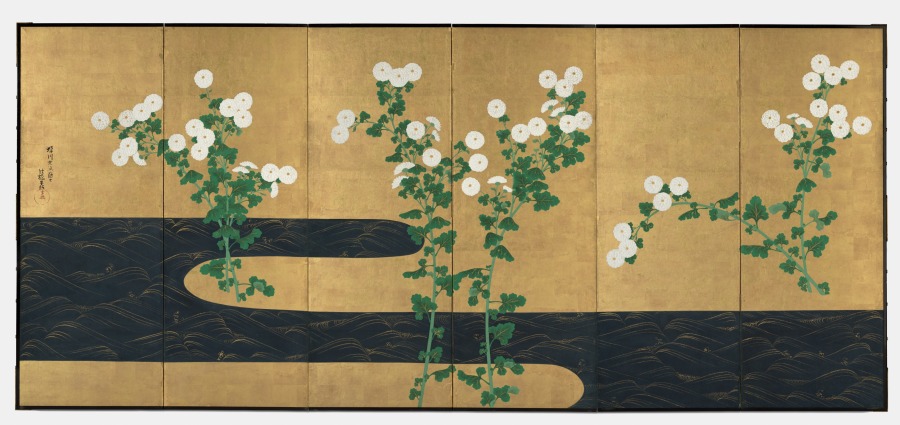| schema:description 10 | "creditline: Gift of the Hanna Fund" |
| schema:description | "technique: One of a pair of six-panel folding screens; ink and color on gilded paper" |
| schema:description | "collection: ASIAN - Folding screen" |
| schema:description | "type: Painting" |
| schema:description | "inscription: the signature and seal of Korin, "sensen mappa (makko) inshi hokyo Korin" (late generation hermit of the Kamo stream tradition) is written in two lines. A circular seal which reads "Hoshuku" is at the end of the second line on the edge of the first panel from the right....(more)" |
| schema:description | "wall_description: The two lines of script prominently written on the outermost panel of this screen (<em>byōbu</em>) identify the author as Kōrin, one of the most renowned of all Edo period painters. Together with Tawaraya Sōtatsu (died c. 1640) and Ogata Kenzan (1663-1743), Kōrin's younger brother, he represents one of the stalwarts of the Rinpa school of later Japanese painting. While Kōrin enjoyed a privileged childhood in Kyoto, by his late thirties he was struggling on his own as a painter, following the bankruptcy of the family business. <br><br>As the signature on this byōbu contains the honorary title Hōkkyō (Bridge of the Buddhist Law), which was given to particularly talented artists in the Edo period, this screen and its mate are dated by some scholars after 1701, the year that title was officially introduced. (However, it had been in use much earlier.) Not long after, in 1704, Kōrin left Kyoto to attempt a career in Tokyo. He apparently expected strong backing from the collectors and patrons there but came away in 1709 to settle again in Kyoto. There he not only embarked on individual private commissions but also completed several noteworthy collaborative projects in various media with Kenzan. Especially remarkable were their combined efforts to produce stoneware ceramics with inventive painted designs that became prized utensils among connoisseurs of the tea culture. <br><br>These chrysanthemum byōbu typify a painting genre that came to be identified with Kōrin and much less so with Kenzan or their talented follower Sakai Hoitsu (1761-1828). Highly stylized backgrounds accentuate floral groupings that have been groomed so as to appear utterly artificial, like the synthetic arrangements available today. Kōrin's genius derives in large measure from natural phenomena painstakingly observed and then manipulated to create compositions of startling refinement and sparkling isolation. This process may have grown out of Kōrin's early immersion in the family textile business, a medium that encourages such dramatic distillations of form: the stream's limpid patterns of gold-crested waves recall many traditional kimono robe designs of the era. Or perhaps Kenzan's influence and his proclivity for producing astringent "arrangements" of perfectly intact flora set against blank or gold-foil backgrounds propelled an anonymous Kōrin follower. Either way, the demand for Kōrin's work and for paintings in the Kōrin style (Rinpa) more so than that of any other school of the period is clear in the history of later Edo era painting. <br><br>Chrysanthemums appear alongside streams in early compositions by or attributed to Sōsetsu as well as to Kōrin and his followers in a number of formats other than byōbu: fans and painted designs on gold-foil wrapping papers for incense come to mind. This late summer/autumnal subject apparently became identified with Kōrin's name, his workshop, and later followers, resulting in works such as this pair of byōbu, one of the few brilliant large-scale compositions of the later Rinpa genre in Western collections. As yet, no other paintings currently ascribed to Kōrin have been identified with these inscriptions....(more)" |
| schema:description | "measurements: Image: 163.2 x 369.9 cm (64 1/4 x 145 5/8 in.)" |
| schema:description | "tombstone: Chrysanthemums by a Stream, late 1700s-early 1800s. Follower of Ogata Korin (Japanese, 1658-1716). One of a pair of six-panel folding screens; ink and color on gilded paper; image: 163.2 x 369.9 cm (64 1/4 x 145 5/8 in.). The Cleveland Museum of Art, Gift of the Hanna Fund 1958.206.2...(more)" |
| schema:description | "id: 135182" |
| schema:description | "culture: Japan, Edo period (1615-1868)" |

